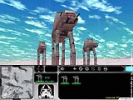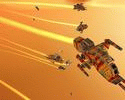|
StarCraft, while it had beautiful graphics,
was still pushing 2D sprites
around 2D tilesets. At the same time, Dark Reign and
Total Annihilation both
boasted 3D terrains which let your tanks wobble as they clambered over a hill
or your submarines waver through the refractive index of water.
Starting in 2000, RTS games
pushed the concept of 3D further to include a freely rotating viewpoint.
The first attempts, like Force Commander from LucasArts,
failed miserably due to awkward camera controls, while
3D RTS latecomers, like Homeworld from Sierra,
learned from these early mistakes and yielded breathtaking, cinematic gameplay.
 |
|
 |
The much-maligned Force Commander.
|
|
Sending your fighters into battle in Homeworld.
|
|